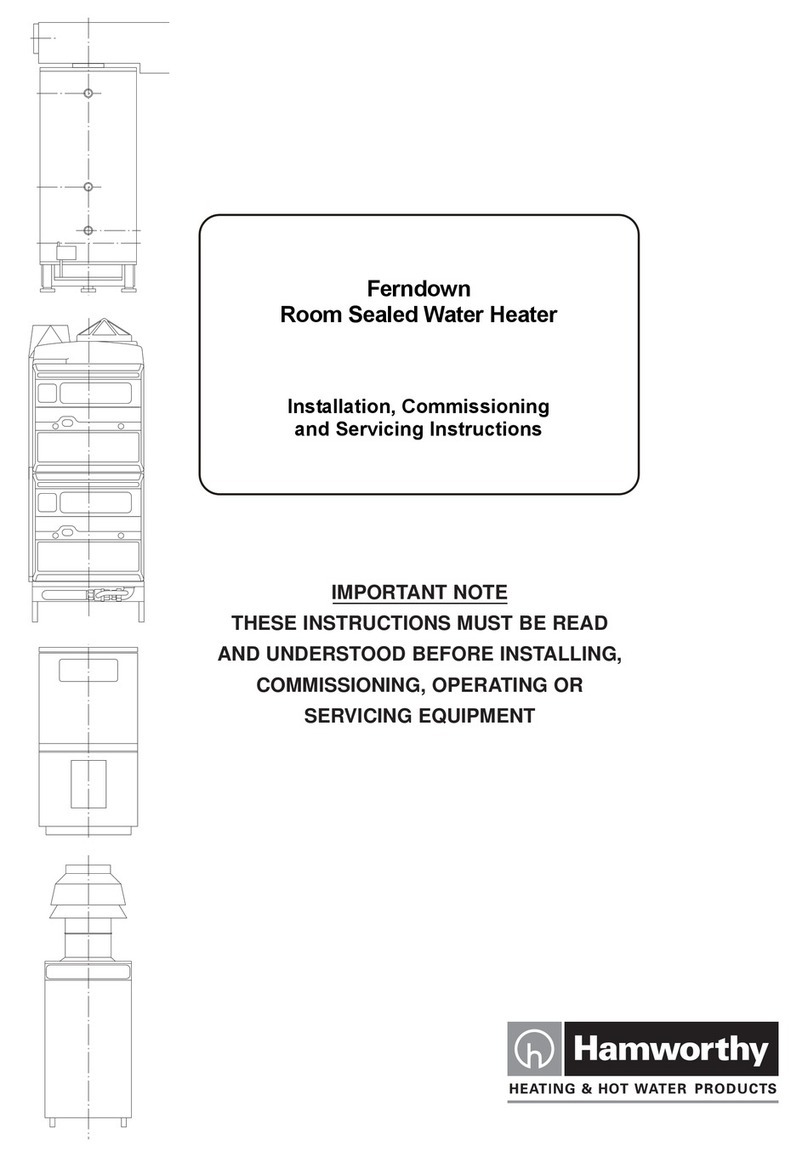HAMWORTHY HEATING LTD
Page
DORCHESTER PERM PILOT
500001001/G
5
ments of BS 3456 Part 101 Clause 27.3
NOTE: If a DRL heater is to be used in conjunction
with a Storage Tank, further wiring will be required
to complete the circuitry for the storage tank thermo-
stat and loading pumps. Therefore refer to para-
graph ‘Electrical Connections - Storage Tank’.
11.0 CONTROL SYSTEM
11.1 Control Thermostat.
The hot water outlet temperature is regulated by a
single control thermostat (B1N) which senses, via a
pocket, the heater water temperature and is located
at the top front of the heater as detailed in Fig. 1.
The thermostat contacts normally closed are con-
nected in series with the main live supply to the
Honeywell gas valve and earthed back to earthing
terminals within the heater junction box - see Fig. 4.
The control thermostat is graduated for a 35°C to
90°C operation but to comply with Hamworthy rec-
ommendations the outlet temperature should be
regulated up to a maximum of 60°C. The thermostat
is fitted with an internal stop, restricting the settings
between 35°C and 60°C.
11.2 Limit Thermostat
A fixed 85°C thermostat (B1F) is pre-wired in series
with the pilot flame thermocouple via a thermocou-
ple interrupter - reference Fig. 4 and 5. In the event
of the thermocouple interrupter limit thermostat be-
ing activated, the flame signal from the pilot thermo-
couple to the Honeywell valve is broken, both the
pilot and the main flame are then extinguished and
the heater shuts down under a lockout condition.
The limit thermostat is the thermal resetting type,
but the heater will not re-fire until the pilot flame is
re-established as detailed in the commissioning in-
structions under the paragraph ‘Commissioning’.
NOTE: In the event of the overheat limit thermostats
being activated, the complete heater installation
should be inspected to trace and isolate the cause
of the problem before any further firing takes place.
12.0 COMMISSIONING
12.1 Checks
Before attempting to commission any heater ensure
that any personnel involved are aware of what ac-
tion is to be taken and begin by making the following
checks:-
a) Flueway passages to the chimney are clear.
b) Adequate ventilation exists in the boiler-
house - reference Table 3.
c) The system is vented fully charged with water
and ready to receive heat.
d) The gas supply pipework is clear of any loose
matter, tested for soundness and purged.
e) Gas supply is connected but turned off, gas
cock is closed, unions are tightened (with any
seals in position), test points are tight, burners
are correctly positioned, injectors are tight
and the pilot is connected from the control
valve.
f) Electricity is connected, but ensure that the
supply is switched off.
12.2 Procedure for Lighting (Permanent Pilot Igni-
tion)
Turn control thermostat to the minimum setting (35°
C) and ensure electrical supply is off.
Open heater gas cock.
Depress fully start button (white) on gas valve
(allowing gas to pass to the pilot burner) and ignite
burner by repeatedly pressing the Piezo electric ig-
nitor.
When the pilot is alight, maintain the start button de-
pressed for a further twenty seconds, allowing ade-
quate current to be generated by the thermocouple
to hold the pilot valve open.
If the pilot does not light, re-vent the gas lines to out-
side the building and check whether gas is present
at the pilot. The start button must be fully de-
pressed.
Having established the pilot, release the start but-
ton, remove the pilot adjustment cover screw on the
valve - see Fig. 5 - and adjust the screw beneath to
give a pilot flame envelope of 12 mm (0.5”) long
around the thermocouple.
After pilot adjustment, check that any electrical cir-
cuits are closed and switch on the power supply to
the appliance. Adjust the control thermostat to the
recommended required setting (to a value not ex-
ceeding 60°C) after which the gas valve will open
and the main burner will light.
After the heater has operated for approximately five
minutes, switch off power, slacken the gas pressure
test point, screw on the Honeywell valve - see Fig.
5 - and fit a manometer. Switch the heater on and
measure the operating gas pressure. Check read-
ings against pressure required in Table 1. Adjust
control valve regulator as necessary by removing
cap and using a screwdriver, turning the nylon ad-
justing screw beneath clockwise to increase, anti-
clockwise to decrease the pressure. Switch off
burner by isolating power supply.
Remove manometer, remembering to re-tighten
pressure test point. Relight the burner and check
that no waste gas spillage occurs from any draught
diverter. Check operation of control thermostat by





























